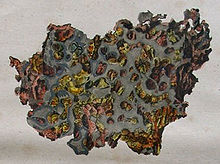Krasnojarsk (meteorite)
| Krasnojarsk | |
|---|---|

Hand-colored drawing
|
|
| Type | Stony–iron |
| Structural classification | Medium octahedrite |
| Class | Pallasite |
| Group | Pallasite Main Group |
| Country | Russia |
| Region | Krasnoyarsk Krai |
| Coordinates | 54°54′N 91°48′E / 54.900°N 91.800°ECoordinates: 54°54′N 91°48′E / 54.900°N 91.800°E |
| Observed fall | No |
| Found date | 1749 |
| TKW | 700 kg |
Krasnojarsk was the first pallasite meteorite ever found.
A mass of about 700 kilograms (1,500 lb) was detected in 1749 about 145 miles south of Krasnoyarsk. It was seen by P.S. Pallas in 1772 and then, on his orders, transported to Saint Petersburg.
Krasnojarsk was the first pallasite meteorite ever found and studied and led to the creation of the Pallasite group, named after Pallas. It was also the first meteorite ever etched with acid (by G. Thomson) and therefore was the first one to show to human eyes the Widmanstätten pattern.
The main mass of 514.557 kilograms (1,134.40 lb) is now in Moscow at the Fersman Mineralogical Museum, Russian Academy of Sciences.
It is a stony–iron meteorite of the Main Group Pallasite (MGP) group.
...
Wikipedia
